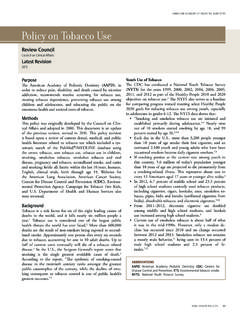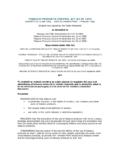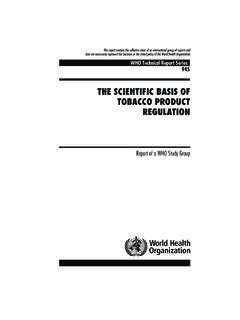Transcription of The truth about the tobacco industry …in its own …
1 The truth about the tobacco its own wordsTobacco Explained was originally developed and written by Clive Bates and AndyRowell for the London-based Action on Smoking and health(ASH).It has been adapted for World No tobacco Day. For further details and hundreds ofadditional extracts from tobacco industry papers visit ASH at: WHO's comprehensive tobacco Free Initiative resources at: .SummaryThousands of internal tobacco industry documents released through litigation andwhistleblowers reveal the most astonishing systematic corporate deceit of all time. Whatfollows is a survey of the documents, 1,200 relevant and revealing quotes grouped undercommon 1 Smoking and health Publicly the industry denied and continues to deny that it isclear that smoking causes lung cancer - yet it has understood the carcinogenic nature of itsproduct since the 1950s.
2 It is now clear that the industry s stance on smoking and health isdetermined by lawyers and public relations 2 Nicotine and addiction Until recently the industry has denied its product isaddictive. Most recently it has used a definition of addictiveness so broad that it encompassesshopping and the Internet. Internally, it has known since the 1960s that the crucial selling pointof its product is the chemical dependence of its customers. Without nicotine addiction therewould be no tobacco industry . Nicotine addiction destroys the industry s PR and legal stancethat smoking is a matter of 3 Marketing to children The companies deny that they target the young. Thedocuments reveal the obvious - that the market of young smokers is of central importance to theindustry. Many documents reveal the companies pre-occupation with teenagers and youngerchildren - and the lengths they have gone to in order to influence smoking behaviour in this 4 Advertising The industry maintains that advertising is used only to fight forbrand share and that it does not increase total consumption - academic research showsotherwise.
3 The documents show that advertising is crucial in nurturing the motivation to smokeby creating or projecting the positive values, such as independence, machismo, glamour orintelligence, erroneously associated with the 5 Cigarette design The documents show that the companies initially hoped tomake safer cigarettes, but then abandoned the enterprise when it recognised that this wouldexpose their existing products as unsafe . The industry has deliberately promoted low-tar cigarettes knowing that they would offer false reassurance without health benefits. It hasmanipulated nicotine and introduced additives to change the delivery of nicotine. It recognisesthe cigarette as a drug delivery 6 Second-hand smoke The industry is challenged by second-hand smoke in twoways. First, measures to protect non-smokers will reduce the opportunities to smoke andcontribute to its social unacceptability.
4 Second, the freedom to smoke arguments areconfounded if non-smokers are harmed. The industry has refused to accept the nowoverwhelming consensus regarding the harm caused by second-hand smoke - instead it hasdenied and obfuscated, and sought to influence debate by buying up scientists on a 7 Emerging markets Faced with reducing levels of smoking in the West and aninsatiable need for money, the companies have moved aggressively into developing countriesand Eastern Europe. The documents reveal an arrogance and fanaticism that has views of the tobacco industryTaken together the documents challenge the tobacco industry s cosy explanation of itself - asthe supplier of a legal product used for a widely-enjoyed social habit by adults who are fullyaware of the risks and choose to take them to experience the a much darker explanation emerges: it is a predatory industry whose market dynamicsdemand that it recruits young people.
5 It does this by deploying vast promotional expendituresto create, communicate and amplify a set of positive values associated with the product. Oncethe glamour phase subsides, nicotine addiction takes over making the customer dependent onthe product and securing a profitable cash flow. Trapped by nicotine addiction, the smoker issubject to a variety of sub-lethal illnesses which culminate in a one in two probability of deaththrough smoking-related disease. The smoker s death means a replacement customer must befound - and the cycle begins and realities the tobacco industry must acceptJustification for taking strong measures against the tobacco industry must be based on facts andrealities that command wide assent. Ten facts and realities justified by the tobacco industry sown documents, are set out below.
6 The industry should now be required to admit these:1. That smoking causes many kinds of cancer, heart disease and respiratory illnesses which arefatal for many sufferers. The industry still does not publicly accept that smoking causeslung That annual global death toll caused by smoking is 4 million. By 2030, that figure will riseto 10 million with seventy percent of those deaths occurring in developing That nicotine is the most important active ingredient in tobacco ; that the tobacco companiesare in the drug business; the drug is nicotine and that the cigarette is a drug delivery industry maintains it is a simple consumer goods That nicotine is physiologically and psychologically addictive, in a similar way to heroinand cocaine - rather than shopping, chocolate or the Internet. The overwhelming majorityof smokers are strongly dependent on nicotine and that this is a substantial block tosmokers quitting if they choose to.
7 The industry still maintains that nicotine is notaddictive in the sense used That teenagers (13-18) and children (<13) are inherently important to the tobacco marketand that companies are competing for market share in these age groups. The industrymaintains that its business is only focussed on That advertising increases total consumption as well as promoting brand share. Theindustry flatly denies That advertising is one (of several) important and interlocking ingredients that nurturesmoking behaviour among teenagers and children. The industry denies its advertisinginfluences the smoking behaviour of That current formulations of low tar cigarettes create false health reassurance and offer littleor no health benefit. The industry has either not publicly accepted this or argued that itnever claimed any health That second-hand smoke is a real public health hazard, including causing childhooddiseases such as asthma, bronchitis, cot-death and glue ear, and is a cause of lung cancerand heart disease in adults.
8 The industry has mounted a major disinformation campaign inthis the tobacco industry has the normal duty of any manufacturer to ensure that it does notmarket a defective product and that its products are as safe as of contents1 SMOKING AND HEALTH .. WHAT IS KNOWN - KEY FACTS ON SMOKING AND WHAT THE industry KNEW AND WHAT IT AND WHAT IS KNOWN - KEY FACTS about NICOTINE WHAT THE industry SAID AND WHAT IT TO CHILDREN .. WHAT IS KNOWN - KEY FACTS about MARKETING TO WHAT THE industry SAID AND WHAT IT .. WHAT IS KNOWN - KEY FACTS ON ADVERTISING AND WHAT THE industry SAID AND WHAT IT DESIGN: ADDITIVES, LOW-TAR AND 'SAFE' WHAT IS KNOWN - KEY FACTS ON LOW TAR AND SAFE WHAT THE tobacco industry SAID AND WHAT IT SMOKE.
9 WHAT IS KNOWN - KEY FACTS about SECOND-HAND WHAT THE tobacco industry SAID AND WHAT IT EMERGING MARKETS .. WHAT IS KNOWN - KEY FACTS about THE MOVE INTO DEVELOPING WHAT THE tobacco industry SAID AND WHAT IT and health11 Smoking and health A demand for scientific proof is always a formula forinaction and delay and usually the first reaction of theguilty .. in fact scientific proof has never been, is not andshould not be the basis for political and legal action An example of (private) candour from a scientist at the tobacco company BAT 1. (S J Green1980) SummaryAt the beginning of the fifties, research was published showing a statistical link betweensmoking and lung cancer. At the same time the tobacco industry s own research began to findcarcinogens in smoke and began to confirm the relationship between smoking and posed a serious problem for the industry : whether to admit to the health problems and tryand find marketable solutions, or whether to basically deny the face of mounting damning evidence against their product, the companies responded bycreating doubt and controversy surrounding the health risks, whilst at the same time byresponding to the growing public concern by putting filters on cigarettes and promisingresearch into the health effects of smoking.
10 They lulled the smoking public into a false senseof security, because, whilst this had the hallmarks of responsible companies acting in thepublic interest, it was actually a public relations strategy to buy time, at the expense of of the internal documents reveal that the industry was trying to look responsible inpublic, but privately was out to convince the public that smoking was not harmful. Despitedecades of evidence to the contrary, and millions of deaths caused by tobacco , the industrystill largely maintains that the case against the cigarette is unproven. In the early fifties, research is published showing a statistical link between smoking andlung cancer. At the same time the industry s own research begins to find carcinogens insmoke and starts to confirm the relationship between smoking and cancer.















